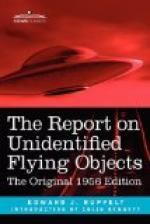But the biggest argument against the object’s being a balloon was the fact that the pilot pulled in behind it; it was directly off the nose of his airplane, and although he followed it for more than a minute, it pulled away from him. Once you line up an airplane on a balloon and go straight toward it you will catch it in a matter of seconds, even in the slowest airplane. There have been dogfights with UFO’s where the UFO’s turned out to be balloons, but the pilots always reported that the UFO “made a pass” at them. In other words, they rapidly caught up with the balloon and passed it. I questioned this pilot over and over on this one point, and he was positive that he had followed directly behind the UFO for over a minute and all the time it was pulling away from him.
This is one of the most typical UFO reports we had in our files. It is typical because no matter how you argue there isn’t any definite answer. If you want to argue that the pilot didn’t know where he was during the chase—that he was 3 or 4 miles from where he thought he was—that he never did fly around the northern edge of the field and get in behind the UFO—then the UFO could have been a balloon.
But if you want to believe that the pilot knew where he was all during the chase, and he did have several thousand hours of flying time, then all you can conclude is that the UFO was an unknown.
I think the pilot summed up the situation very aptly when he told me, “I don’t know what it was, but I’ve never seen anything like it before or since—maybe it was a spaceship.”
I went back to Dayton stumped—maybe it was a spaceship.
CHAPTER TEN
Project Blue Book and the Big Build-Up
Just twenty minutes after midnight on January 22, 1952, nineteen and a half hours after the Navy lieutenant commander had chased the UFO near Mitchel AFB, another incident involving an airplane and something unknown was developing in Alaska. In contrast with the unusually balmy weather in New York, the temperature in Alaska that night, according to the detailed account of the incident we received at ATIC, was a miserable 47 degrees below zero. The action was unfolding at one of our northernmost radar outposts in Alaska. This outpost was similar to those you may have seen in pictures, a collection of low, sprawling buildings grouped around the observatory--like domes that house the antennae of the most modern radar in the world. The entire collection of buildings and domes are one color, solid white, from the plastering of ice and snow. The picture that the outpost makes could be described as fascinating, something out of a Walt Disney fantasy—but talk to somebody who’s been there—it’s miserable.
At 0020, twenty minutes after midnight, an airman watching one of the outpost’s radarscopes saw a target appear. It looked like an airplane because it showed up as a bright, distinct spot. But it was unusual because it was northeast of the radar site, and very few airplanes ever flew over this area. Off to the northeast of the station there was nothing but ice, snow, and maybe a few Eskimos until you got to Russia. Occasionally a B-50 weather reconnaissance plane ventured into the area, but a quick check of the records showed that none was there on this night.




